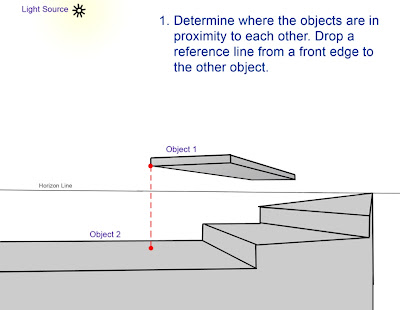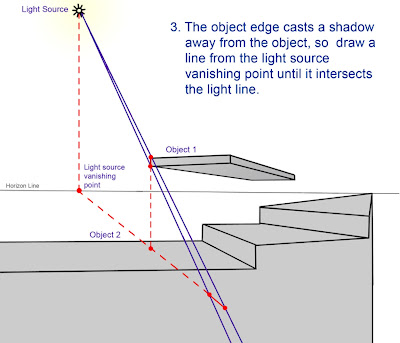| Shadow is the darkness that results because an object blocks light from hitting another object. Light from other sources will change how the shadow appears. Often shadow farther from the object will be less dark and less crisp. In this image, notice that the light reflecting from the pitcher brightens part of the shadow from the block in front of it. This is different than shade. Shade is the dark part of an object that doesn’t receive light. The front of a pitcher, for example, reflects light toward the viewer and the back side is in shade. The pitcher casts a shadow on the ground and wall. It is easier to consider where shadow and shade will be if you consider that light travels in a straight line. If you explode a balloon full of paint where the light source is, the area blocked by the object from getting sprayed by paint is where shadow will be. This makes it easier to figure out what this shadow area is. Just draw straight lines from the light source to the outside edges of the object. Continue that line until it hits the other object. You need to use the object’s same perspective points for the shadow. The cast edge of the object does not change vanishing points. A ball’s shadow will cast as an oval, and it will go to the same vanishing points. |
Join Coaching centre ...!!!
Shadow Vanishing Points
Raised Object
Cut out alower part of the object. You have a floating object. The only difference in the shadow is now you have light shining through the part that got cut out. Draw light lines to this new lower edge and find where they intersect your existing shadow lines.
Complex Shadows
As you figure out the dimensions of the shadow edges, the important thing to know is if the edge vanishes toward the object vanishing point or toward the light vanishing point. Just remember that if the shadow edge is being cast away from the object, you use the light vanishing point. If it is following the object, you use the object vanishing point.







Tilted Object
What if the second object is not aligned with the first object? First figure out how tilting an object changes the perspective points. The shadow edges that vanish toward the first object’s vanishing points change. Their new vanishing point moves some amount toward the new object 2 vanishing point, depending on how much the object is tipped. All other shadow edges use the same vanishing points.
Twisted Object
Twisting an object is similar:
Drawing The Shadow
 Color– Every light has a color to it. The sun is orangish-yellow. In places where the light doesn’t hit the object, the color of the object looks different. It will have a complementary tint of color in its shadow. This is why buildings in the sun have a purplish shadow.
Color– Every light has a color to it. The sun is orangish-yellow. In places where the light doesn’t hit the object, the color of the object looks different. It will have a complementary tint of color in its shadow. This is why buildings in the sun have a purplish shadow.Gradient edge– The softness of a shadow’s edge depends on three things.
- The type of light source. An ambient light produces soft edges and a hard spot light makes crisp edges.
- The distance of the cast shadow from object 1. A shadow cast over a long distance will diffuse light at the ends. Shadows will be crisper at parts close to the object.
- The object. The texture and quality of both objects determine how crisp the shadow gets.






No comments:
Post a Comment